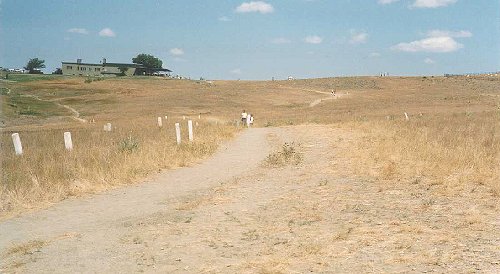
Little Big Horn
June 25, 1876
White settlement of the Black Hills touched off an Indian war in 1876. To deal with the uprising, three columns of a total of 2,500 men were sent against the Indians. A column under George Crook moved north from Fort Fetterman in Wyoming Territory and was repulsed at Rosebud. Infantry under Brig. Gen. Alfred Terry screened by the 7th Cavalry under Lt. Col. George Armstrong Custer moved west from Fort Lincoln in Dakota Territory on May 17th. They met up with a column under Col. John Gibbon approaching from Fort Ellis further west. Terry, Gibbon, and Custer determined to send Custer's cavalry south along the Rosebud Creek toward the Little Big Horn and Crook's column to find the Indian camp. On June 25th, traveling along a ridge overlooking the Little Big Horn, Custer found the camp and determined to attack with his 600 men. He apparently could not see the entire camp, which included over 7,000 Indians, 2,000 of whom were warriors. Custer kept 115 men in three companies under Cpt. Frederick Benteen on the ridge while 140 men in three companies under Maj. Marcus Reno crossed the river and attacked the near end of the camp. Custer continued with 210 men in five companies along the ridge to attack the other end of the Indian camp. Reno's attack was shattered, with losses of 40 killed, 13 wounded, and a number of missing. The survivors rushed back across the river and up the ridge to join Benteen. The Indians now shifted to fight Custer.
Further down the ridge, Custer tried to cross the river but was repulsed. The men continued down the ridge. Exactly what happened next is not known. They may have been moving again to cross the river and attack the camp, but they became spread out and the Indians attacked and killed them to a man. The stone markers show where their bodies were found. Some ran to the ravine, but they too were killed. These pictures are of the general area.

From Near the Visitors Center
Custer and his own group were killed in the fenced off area atop the hill.

From Part Way Down the Hill
Custer's own small group was killed on top of the hill on the far right. Many of his men were killed all along the hillside.

From Further Down the Ridge
Custer's own small group was on top of the ridge in the second picture from the left. The ravine can be seen on the far right. The ravine extended far up the hillside.